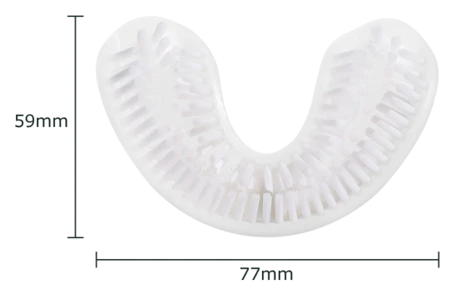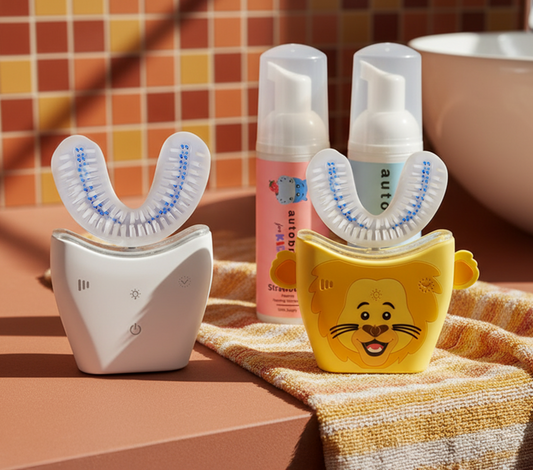
Curing Gingivitis: Symptoms, Treatments, and Prevention
Gingivitis is a common oral health issue that affects millions of people worldwide. It is an early stage of gum disease caused by the buildup of plaque on teeth. If left untreated, gingivitis can progress into a more severe condition known as periodontitis, which can lead to tooth loss and other serious complications. In this blog post, we will explore the symptoms and appearance of gingivitis, understand what it is, and discuss effective at-home treatments. Moreover, we'll look into the importance of regular brushing to prevent gingivitis and how using an advanced toothbrush like AutoBrush can be beneficial for those susceptible to gingivitis.

Understanding Gingivitis: Symptoms and Appearance
Gingivitis is characterized by inflammation and irritation of the gums. The common symptoms include:
- Red and swollen gums: Gingivitis causes the gum tissue to become tender and puffy, making it appear more prominent and redder than usual.
- Bleeding gums: Gums may bleed easily, especially during brushing, flossing, or even when eating certain foods.
- Bad breath (halitosis): The presence of bacteria in the mouth due to plaque buildup can cause persistent bad breath.
- Receding gum line: As gingivitis progresses, the gums may start to recede, exposing the roots of the teeth and causing sensitivity.
- Formation of pockets: Spaces may develop between the teeth and gums, where bacteria can accumulate, leading to further inflammation.

What is Gingivitis?
Gingivitis is primarily caused by the accumulation of plaque, a sticky film composed of bacteria, mucus, and food particles, on the teeth and gum line. When not removed regularly through proper oral hygiene practices, plaque can release toxins that irritate and inflame the gums. Over time, this can lead to the development of gingivitis.

At-Home Treatments for Gingivitis
Fortunately, gingivitis can be treated effectively, especially when caught early. Here are some at-home treatments to help combat gingivitis:
- Proper Oral Hygiene: The cornerstone of gingivitis treatment is maintaining proper oral hygiene. Brush your teeth at least twice a day using fluoride toothpaste and a soft-bristled toothbrush. Be sure to clean the gumline and the back of your molars thoroughly. Additionally, floss daily to remove plaque and food particles between teeth and under the gumline.
- Mouthwash: Using an antimicrobial mouthwash can help reduce the number of bacteria in your mouth and control plaque buildup.
- Warm Saltwater Rinse: Rinsing your mouth with warm saltwater can help soothe inflamed gums and promote healing. Mix half a teaspoon of salt in eight ounces of warm water and swish it around your mouth for 30 seconds before spitting it out.
- Aloe Vera Gel: The anti-inflammatory properties of aloe vera can be beneficial for reducing gum inflammation. Apply a small amount of natural aloe vera gel to your gums and gently massage it.
The Role of Regular Brushing in Preventing Gingivitis
Prevention is the best approach when it comes to gingivitis. Regular brushing helps eliminate plaque and prevents its buildup, reducing the risk of gum inflammation. Make sure to brush your teeth for at least two times a day, reaching all surfaces of the teeth and the gum line.
Introducing the AutoBrush: A Game-Changer in Gingivitis Prevention
For individuals prone to gingivitis or those seeking an extra level of oral care, an advanced toothbrush like AutoBrush can be a game-changer. The AutoBrush features innovative u-shaped bristles that encompass all teeth simultaneously, ensuring a more efficient and thorough cleaning process. This design allows for optimal plaque removal along the gum line, reducing the risk of gingivitis development.

To Recap
Gingivitis is a prevalent oral health issue, but with proper understanding, care, and regular brushing, it can be effectively treated and prevented. Maintaining good oral hygiene practices, such as regular brushing and flossing, along with at-home treatments like saltwater rinses and using an antimicrobial mouthwash, can significantly improve gum health.
For those seeking an advanced toothbrush to complement their oral care routine, the AutoBrush with its u-shaped bristles and smart features provides an efficient and effective solution. By taking the necessary steps to combat gingivitis, you can ensure a healthy and beautiful smile for years to come.












